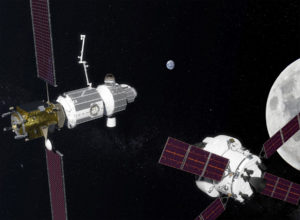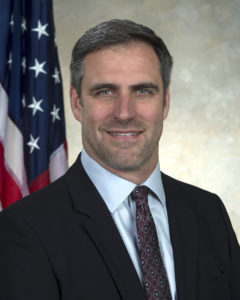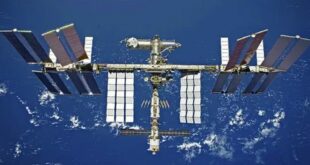
NASA’s Lunar Orbital Platform-Gateway is set to be a staging post in space – a science lab, communications hub, and holding area for robots and rovers and a jumping off point for future deep space transportation. The Gateway will be pivotal for the expansion of humanity’s presence on the Moon, Mars, and in deeper space. In the sidelines of the SGAC Space Generation Congress in Bremen, Germany, SpaceWatch.Global’s Torsten Kriening managed to spend some time with R. Marshall Smith, Director, Cross Program Systems Integration, Exploration Systems Development, Mission Directorate, NASA, who is part of the team developing the Gateway programme and shared his insights into this incredible and important initiative.
Please begin by telling us about yourself and your job at NASA.
I am the Systems Engineering and Integration lead for Exploration Systems Development. We are building the Space Launch System (SLS), Orion crew vehicle, Exploration Ground System (EGS), and putting them together to make our next deep space transportation system. On top of that, over the last year I’ve been involved with helping to formulate the Gateway programme.
Let’s talk about the Gateway because that really is the next big thing. What is the vision of the project?
We have been talking about what we want to do and how we take the next step beyond LEO (low-Earth Orbit). How do we move farther into space? How do we get to Mars and to other destinations? One of the concepts is to have a place out of Earth’s gravity well where we can live and work, that’s a launching-off point for other space activities on the Moon or to other destinations such as Mars. This has always been intended as something small. We are not repeating ISS (International Space Station). It will be crewed for a short period of time—for 30, 60, 90 days at the most. It’s about 10 percent of the size of the ISS and the overall concept is really to get used to working in deep space.
There are a lot of operations that we need to understand, such as how we navigate in certain types of gravity that we aren’t accustomed to. For example, we are used to how to move around in LEO, but we are talking about moving into very unique orbits such as a Near-Rectilinear Halo Orbit to L2 (Lagrange Point) or to low-lunar orbit. Those are things that we don’t have a lot of experience with and we haven’t explored that area for 50 years, since we last went to the Moon. Those are some of the things that we want to get experience with, as well as how to operate in deep space.
We’re hearing that international co-operation will be a key element of the Gateway. Is that still the case?
Yes. We have been working with our international partners as well as our U.S. industry partners as part of the development and concept formulation, asking what kinds of things we could do. We are doing development exercises and analysing the kinds of activities we might want to carry out at the Gateway. We recently went to the NAC (NASA Advisory Council), and we rolled out the areas where we think international countries could be involved with the Gateway. We received strong encouragement from the NAC to continue pursuing Gateway development with both international and industry partners.
So are the international partners the same agencies of the countries involved on ISS?
Yes. It is very similar to what we have done in the past. That’s not to say it won’t change in the future, but we are at a formulation point at this time.
How will you select the companies that are bidding for contracts on the Gateway?
We have a number of companies that are involved and some of them also have their own partners. We have asked them to come up with their own deep space habitation designs from concept (Phase 1) through Phase 2, when the partners will demonstrate ground-based simulators so we can actually come in and see how equipment might work and how astronauts might move around within these concepts.
We want to spur innovation. We don’t want to hand out a list of requirements that is 2 inches thick. We are asking industry, and other folks who are participating, to be innovative. We will then evaluate the concepts that they come back with and the best of them will be used to formulate our high-level requirements for the next components for Gateway. Then, there will be a competitive process for that particular component that everyone can become involved with, but it will be based on what we have learned through this process.
We want to have an open architecture and we are really pushing for deep space interoperability standards. We would like drive economic growth in deep space, by providing these standards we can allow others to easily interface with the Gateway. For example, a spacecraft can use the Gateway as a jumping-off point to the Moon’s surface. Open architecture standards provide the opportunity for others to engage and be part of this whole endeavour.
What is the main focus for the Gateway – is it science? Is it tourism? Or something else?
Our role at NASA is to explore. But we also have space policy directives that have been given to us. The first is about exploration with international and commercial partnerships. The second has to do with leveraging economic capability and streamlining regulations. But the bottom line is that we want to maximise capability for everyone to be able to start using space and the resources in space. Then final one, is about traffic management. So, I would say our main focus is on exploration. We, as an Agency, want to have people in space full time – a permanent presence in deep space. We also want to initiate the commercial development of systems that will contribute to these objectives.
So if Elon Musk wanted to send a tourist around the Moon quite soon, could the Gateway be open kind of commercial opportunity?
That’s a discussion that people are going to have to have. I don’t think that, given the short time that we are going to be there, it would be realistic. There will also only be four crew members there for that time period, and it’s pretty small. I also think most governments are going to want to use the time on the Gateway wisely, and be very careful about the time that they have. Of course, there will be a lot of time when it is autonomously run, and we will use robotics inside the vehicle and outside to conduct experiments for example. But I would say, in general, we are a ways off before we get to the point where we would have ongoing space tourism in deep space.
What policy/regime will apply for the gateway? Will it be similar to the agreements you have today on the ISS with partners that each and everybody has a say?
Those that are participating in the Gateway will be will be on the review and management boards, and will have a say in how we do things with respect to design and operational matters. We are leveraging the ISS agreements right now because it takes a long time to get international agreements in place. Whether that continues and how it continues, I cannot say at this time.
As far as the ISS goes, it is still a very exclusive club of countries and agencies that can visit and work there. Will this potentially change with the Gateway? There are slogans out like ‘space belongs to everyone’. Will this be the case or is it still going along the lines of agreements already in place?
We are looking for partnerships and contributions – particularly contributions. Those who are participating and contributing will obviously get most of the operational time on Gateway. I certainly think our goal is to have the open architecture that will meet the standards in our industry but I am sure that, for those countries that wanted to use the gateway, we would find a mechanism to do that. My personal thought on this is that it will have to be fairly open – we want to remove as many barriers to participation as possible.
Do you envisage one Gateway in the next one or two decades around the Moon or multiple Gateways?
We are building this one with the expectation of a 15-year lifespan. It will probably operate longer than that, but that’s where we are right now. Eventually, we will start taking the next steps such as going to Mars and building the transport systems which may look a lot like a Gateway with updated systems and updated propulsion systems.
In terms of funding, how are things progressing?
Budgets have been put into the system for what it looks like for the next five to seven years and we are working off that and hope to soon be officially funded.
When will we see the first parts of the Gateway in space?
We have actually put out a procurement for the power propulsion element which is the very first piece of the Gateway and that was released in September. The closing date for bids will be 15 November. When we get those, the goal will be to launch that system in 2022. That’s a pretty quick development timeline, but what we are doing is leveraging the industry’s capability to develop these types of systems based on typical satellite communications bus architectures.
Imagine the Gateway is in space and operational. Is there any opportunity for private industry to engage with it? We now have a rush to the Moon from commercial entities. We expect the first to get there in 2019/2020. Are here any ideas of how to bring the two together?
Obviously we are thinking along those lines. The second part of this project is to stimulate the economy and to develop capabilities for the commercial side to have access to the Moon and other resources that might be available in deep space, like mining. The Gateway can certainly be used as a leverage point for those activities.
We are here at the Space Generation Congress and one of the things that was discussed earlier was the fact that we are standing on the shoulders of the Apollo generation and the ISS. In your opinion will the next generation appreciate this or will it scare them?
I have high expectations for the next generation and I have been engaged with the folks at the SGC and they are very excited about the future. Every generation looks at the future and what it holds and I think they will do better than we have. You have Apollo, then the space shuttle, then ISS and I think the next generation is certainly prepared for the next steps. I’m happy to put our legacy in their hands. They’ve shown they are capable of achieving great things.
Talking about new talent and engagement with the youth, do you have difficulty finding talent or are you flooded with hundreds of appropriate applications?
We get a lot of good applications but one of the things we are finding is that there are some areas where it is challenging to get experienced people, such as flight control systems. It’s in those kinds of special disciplines where it has been harder to find people. It takes a long time to get the experience you need to fill a position.
What got you interested in space and what’s your vision of humanity in space?
I would like to see us develop a permanent presence in space where we go out into the solar system and have presence in asteroid belts, doing mining for example. Is that going to happen tomorrow? No, but the steps we are taking now will enable it to happen. I grew up during the Apollo era and I remember seeing the black and white TV pictures and seeing somebody on the Moon. I had a little Apollo rocket toy that I carried with me all the time. When I grew up I wanted to be involved in aviation and went to university and got an opportunity to work with NASA and I have been with NASA ever since. I worked with airplanes and robotic missions to Mars and then eventually got into human spaceflight and have been there ever since. I really have a passion for it which is why I’m still here!
What is your message for the next generation?
I would say don’t let anyone tell you that you can’t do something because if you believe you can do something you probably can. It takes innovation and it takes drive to make things happen and open up the opportunities that are out there. But it can be done.

R. Marshall Smith is the Director Cross-Program Systems Integration/Exploration Systems Development Chief Engineer at NASA’s Marshall Spaceflight Center in Huntsville, Alabama. Prior to his current position, Smith was chief of the System Engineering and Integration Office for the Ares I-X mission and is currently located at NASA’s Langley Research Center in Hampton, Virginia. Smith began his career at NASA in 1987 as a simulation development engineer in the Simulation Systems Branch at NASA Langley, responsible for the design, development, and integration of components into the simulation architecture. Smith has earned numerous honors and awards during his career at NASA. Recognition includes Superior Accomplishment Awards for his work on the Aviation Security Enhancement Research Proposal in 2002, the Airborne Information for Lateral Spacing Concept in 2001, and for his contributions to the Research Flight Deck Simulator Cab Airborne Systems Competency in 2000. He has received multiple Group Achievement Awards and a Performance Award for outstanding technical leadership for the Aft Flight Deck project. Smith holds a bachelor’s degree in electrical and computer engineering from the University of Tennessee and a master’s degree in electrical and computer engineering from the Virginia Polytechnic Institute.
 SpaceWatch.Global An independent perspective on space
SpaceWatch.Global An independent perspective on space




